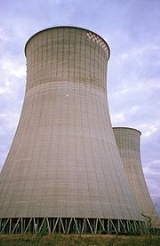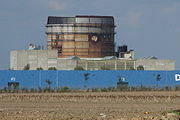
Stendal Nuclear Power Plant
Encyclopedia


Nuclear power
Nuclear power is the use of sustained nuclear fission to generate heat and electricity. Nuclear power plants provide about 6% of the world's energy and 13–14% of the world's electricity, with the U.S., France, and Japan together accounting for about 50% of nuclear generated electricity...
station Stendal was a nuclear power station under construction in East Germany, near the city Arneburg
Arneburg
Arneburg is a town in the district of Stendal, in Saxony-Anhalt, Germany. It is situated on the left bank of the Elbe, approx. 12 km northeast of Stendal. It is part of the Verbandsgemeinde Arneburg-Goldbeck.-History:...
, Stendal
Stendal
Stendal is a town in Saxony-Anhalt, Germany. It is the capital of Stendal District and unofficial capital of the Altmark. Its population in 2001 was 38,900. It is located some west of Berlin and around east of Hanover...
in Bezirk Magdeburg, today Saxony-Anhalt
Saxony-Anhalt
Saxony-Anhalt is a landlocked state of Germany. Its capital is Magdeburg and it is surrounded by the German states of Lower Saxony, Brandenburg, Saxony, and Thuringia.Saxony-Anhalt covers an area of...
.
It was planned to become the largest nuclear power station of East Germany - also the largest nuclear power station in all of Germany
Germany
Germany , officially the Federal Republic of Germany , is a federal parliamentary republic in Europe. The country consists of 16 states while the capital and largest city is Berlin. Germany covers an area of 357,021 km2 and has a largely temperate seasonal climate...
. However, after German reunification
German reunification
German reunification was the process in 1990 in which the German Democratic Republic joined the Federal Republic of Germany , and when Berlin reunited into a single city, as provided by its then Grundgesetz constitution Article 23. The start of this process is commonly referred by Germans as die...
, the safety of the Soviet
Soviet Union
The Soviet Union , officially the Union of Soviet Socialist Republics , was a constitutionally socialist state that existed in Eurasia between 1922 and 1991....
design was under question, and all plans for operation and further construction were completely halted.
Altogether, it was planned to house 4 reactors at the site of the VVER-1000/320 type, which were some of the most modern and largest units of its time (1000 MWe). Construction of unit 1 and 2 began in 1983 and units 3 and 4 remained in planning. Unit 1 was about 85% finished and unit 2 was about 15% finished.
The aboveground connecting building between all units has largely torn off and been weathered down. The emergency diesel generators for unit 1, however, were completed entirely and still stand almost completely intact.
It was planned to have two cooling tower
Cooling tower
Cooling towers are heat removal devices used to transfer process waste heat to the atmosphere. Cooling towers may either use the evaporation of water to remove process heat and cool the working fluid to near the wet-bulb air temperature or in the case of closed circuit dry cooling towers rely...
s per reactor, as was typical with such Soviet designs. The turbine house was connected to the reactor buildings and each reactor had its own turbine and cooling towers in the designs. Several operating plants today have such a design, notably the Temelin Nuclear Power Plant in the Czech Republic
Czech Republic
The Czech Republic is a landlocked country in Central Europe. The country is bordered by Poland to the northeast, Slovakia to the east, Austria to the south, and Germany to the west and northwest....
.
A new innovation for the Stendal plant was that the reactor pressure vessel (RPV) plans were modified heavily by the company SKET in Magdeburg
Magdeburg
Magdeburg , is the largest city and the capital city of the Bundesland of Saxony-Anhalt, Germany. Magdeburg is situated on the Elbe River and was one of the most important medieval cities of Europe....
in connection with the Muscovite
Moscow
Moscow is the capital, the most populous city, and the most populous federal subject of Russia. The city is a major political, economic, cultural, scientific, religious, financial, educational, and transportation centre of Russia and the continent...
planning office. It was to be constructed with a new steel cell composite technique, which differed from other similar plants. This RPV was actually produced, but then was divided and scrapped in 1990/1991 in the course of the deconstructing of the site.
Through the German reunification, the construction was stopped and the three completed cooling towers were demolished in 1994 and 1999 with explosive charges.
The area is an industrial estate today.
See also
Nuclear plants built in the former East Germany- Greifswald Nuclear Power PlantGreifswald Nuclear Power PlantThe Nuclear power station Greifswald , also known as nuclear power station Lubmin, was the largest nuclear power station in East Germany before closure shortly after the German reunification. The plants were of the VVER-440/V-230 type, which was the first generation of Soviet Union designed plants...
- Rheinsberg Nuclear Power PlantRheinsberg Nuclear Power PlantRheinsberg Nuclear Power Station was the second nuclear reactor in East Germany after the Rossendorf Research Reactor, and the first nuclear power reactor in East Germany. It was built close to the city of Rheinsberg on the Stechlinsee...

